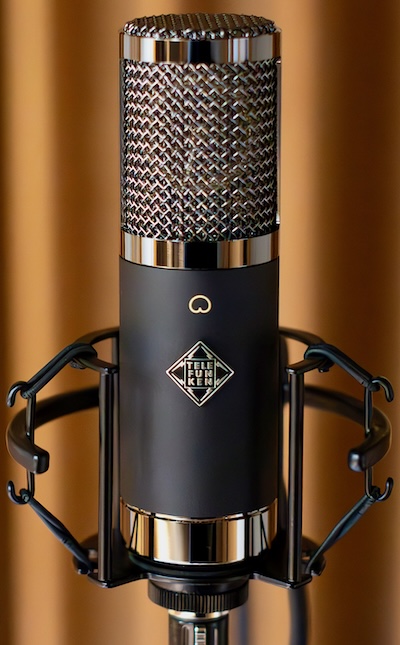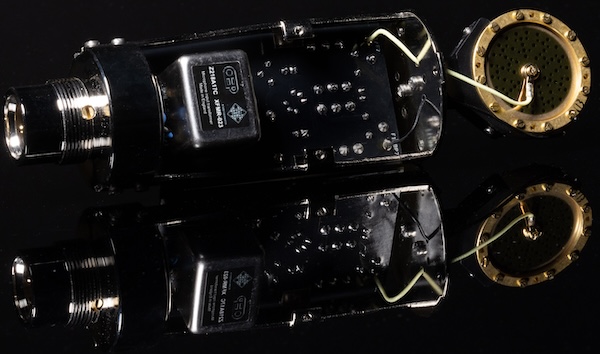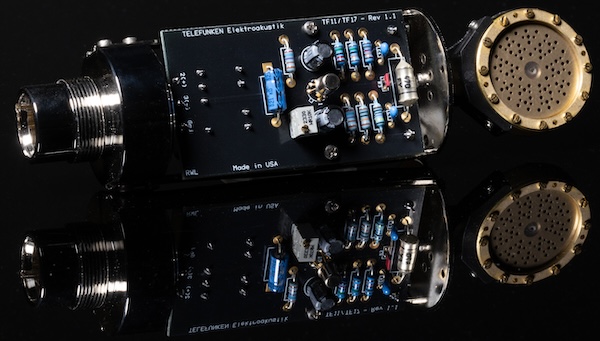
Barry's Mix Magazine Equipment And Software Reviews
Barry's Massive Discography And Engineering Career
Barry's Music Connection Magazine Reviews
Barry's Resolution Magazine Reviews
Telefunken Elektroakustik USA TF17 Large Diaphragm Condenser Microphone
Large Diaphragm Condensr Mic Sounds Great on Any Source
By Barry Rudolph
 |
| Telefunken Elektroakustik USA TF17 |
The Telefunken name goes back to early 20th century. and through the years since, the company has consistently made highly coveted microphones. Now, the Telefunken Elektroakustik TF17 continues the lineage as the latest in the Alchemy Series of large diaphragm microphones.
The series includes six models, starting with the cardioid-only TF11and TF17. Both use FET amplifiers and are +48-volt phantom powered. Tubes are employed in the cardioid-only TF29 Copperhead and the multi-patterned TF39 Copperhead Deluxe mics. The TF47 and TF51, both multi-pattern tube mics are said to be reminiscent of the U47 and ELA M251E classics. All six mics of the Alchemy Series and their power supplies are assembled in the United States.
The TF11 and TF17 do not have switches for polar pattern, HPF, or a capsule attenuator. Switches placed on the microphone itself are often a "point of failure" in a well-used studio condenser. With a maximum SPL greater than 135dB, it would have to be an extreme cases when I might need one.
The TF17
The TF17 is designed to be an all-around, workhorse microphone usable on any source. Its compact form and low weight (545 grams, or 1.2 pounds) come to about 2/3 the overall size of my other FET condensers, which allows it to be positioned closer to sources. It easily fits into tight places within drums kits or under the closed lid of a piano right over the hammer--right where I want it.
It is badged "Telefunken" and has a flat-black finish with black nickel trim around the mesh screen/grille. The mic comes with a stand mount with integrated XLR connector, a shock mount, carrying case, and a soft sleeve/dust cover, and each mic has a serial number plainly visible on its back
 |
Telefunken TF17 Circuit Board With Transformer (Front)
 |
| Telefunken TF17 Circuit Board Component Side (Back) |
Inside is a 34mm, center-terminated K47-style (called TK47S) single membrane capsule with the a FET amplifier driving a nickel-iron core output transformer made by OEP Carnhill Transformers in Cambridgeshire, England. (The TF11 is edge-terminated)
The circuit board inside has all discrete parts soldered onto a board--a very clean assembly with no surface-mount (machine made) assembly used. You can see the simplicity of the circuit, the FET and the transformer.
Frequency response is specified as +/- 3dB 20-Hz to 20-kHz with a S/N ratio of 91 dBA. The included graph indicates a slight high-pass filter starting at 200Hz and is down 5dB by 20-Hz. You can also see a broad, 5dB "presence" boost centered at about 4-kHz for a mid-forward "German" voicing
In The Studio
I wanted to try the TF17 on a lot of different sources: loud guitar amps, drum kit overhead, close to kicks and snares, male singers, and pianos.
Vocals
Large diaphragm condenser microphones are typically used on vocals, and I wanted to record a male singer who sings loud, close to the mic, with occasional peaks that can momentarily distort a condenser microphone.
For this vocal, I used a Retro Instruments' PowerStrip, a single-channel, all-tube signal chain with a mic pre, a Pultec-style passive EQ (not used) followed by a variable-Mu compressor. I also had two other large diaphragm FET mics I know well, each costing between one and two grand.
The TF17 could definitely handle the loud peaks. It as a sensitivity of 12 mV/Pa +/-1dB and I found the presence peak didn't accentuate any sibilance. The other mics required a little more mic gain, and I noticed the TF17's cardioid pickup pattern was very broad—this would be great for two or three backing singers at the same time, although I didn't have the opportunity test it that way.
Guitars
My guitar session went well, and I liked the TF17 placed close, near the surrounding suspension and pointed at the center of my twelve-inch Hellatone 30-watt speaker. I sometimes changed the exact aiming for the double-tracked guitar. There was no problem using a Sunset S1P mic pre-amp and no EQ.
For comparison, I A/B it to my SM7B dynamic with the expected difference--the Shure mic had a much drier, fatter sound. The TF17 held its own with a crisp sound and easily captured all the transients clearly. The Shure is not as transparent as the TF17.
I tried acoustic guitar next. had the TF17 out front about a foot away, aimed where the next joins the body. With the proximity effect reduced, it was spot on for both strumming and finger-picking. The Yamaha guitar had a bright sound in the room and that was faithfully reproduced back in my control room.
Drums
Next I tried the TF17 as a mono overhead positioned about 1 meter above the kit, right over the bass drum pedal's beater. I was working on a Trident 80 Series console, and the mic gain was at minimum. This is one of the best one-mic drum sounds I've ever recorded! With no EQ, the low end was tight with good, fast transient reproduction. I could easily move the mic to get better coverage or feature a particular part of the kit. The high frequencies were balanced--not too bright or distant. What the kit sounded like out in the live room is what I heard in the control room with just the one mic.
Next, I want to see how it sounded close in on the snare drum. I placed the TF17 about 11cm from the center of snare drum, with the back of the mic facing the hi-hat to check for rejection. It sounded great, and it rejected the hi-hat. The leakage tonality was not funny sounding! For hard hitters, I'd likely end up going with a dynamic, as occasionally the TF17 clipped--even with a 15dB inline pad. The level coming from the mic into the console was lower but the clips were still there. For lighter brush playing or smooth jazz music, this would be the perfect mic. Ditto for recording bass drums.
In all these tests, I found an incredibly "tight" low frequency sound, with good and fast attacks, and balanced subharmonic energy.
Piano
The studio has a nice sounding Yamaha upright piano, so I couldn't resist trying the TF17 out in front of the hammers--I would have to get two of these mics to do a proper job of coverage. (There are frequency and gain matched pairs available) And again, the sound using just one TF17 was lovely, with good pickup of the harmonic detail and clarity of the bass strings.
All Around Winner
The TF17 is an all-around utility condenser mic. It is perfect for most sources and is priced to see action in any studio. Highly recommended!
|
|
|
|
|